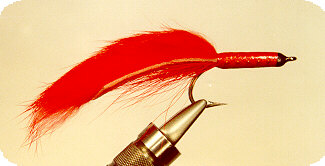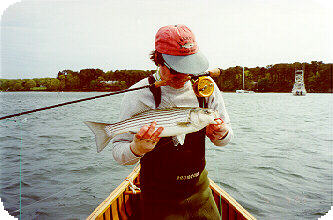WINDRAM'S CINDERWORM

Home | Saltwater Flies | Fly Tying Materials | Saltwater Fly Fishing Accessories
Ordering Instructions, Shipping rates, Your Satisfaction Guaranteed | Site Map

|
Midday was warming into afternoon as Morgan Davis and I unloaded the canoe from the top of my car. From the corner of my eye I could see splashes of water on the far side of the salt pond. Seagulls swooped low to the surface and dipped their beaks into the brine. A few swirls were visible out beyond the boat basin, and we began to hurriedly pack our gear into the canoe. Springtime had come again to Marthaís Vineyard, and with it the cinderworms were swarming in the surface waters of the salt ponds. Close behind the cinderworms came the striped bass, eager for an easy meal after a winterís worth of slim pickings. 
"Cinderworm" is a nickname for any one of a group of segmented marine worms known as the Nereids. Nereid worms consist of many species, and they come to the surface at a variety of times in order to reproduce. They often swarm in great numbers, and with them come the gamefish, eager to feed on such helpless prey. The worms cannot swim very fast, and they cannot avoid the hungry predators, which are never very far behind the swarms. In the Florida Keys, and other southern locations, tarpon, bonefish, and other species feed heavily upon spawning nereids wherever they encounter them. In the Northeast, it is the striped bass that rarely fails to show up for such an easy feed. A warm southerly breeze was blowing as we slipped the canoe into the water, and soon we were gliding quietly out past the moored boats. This would be Morganís first time saltwater fly fishing, and I had guaranteed him that we would find some action. Morgan looked on in amazement as striped bass swirled on either side of the canoe. We fought the urge to begin casting, and dug our paddles in to reach the far side of the pond, where the swirls and breaks seemed more numerous. Suddenly, the water erupted just in front of the canoe, and I could see that Morgan was beginning to lose his composure. With trembling hands I tied one of my own worm flies onto Morganís leader. "Get that fly out there!", I said, but Morgan didnít need any prompting. Within seconds his fly had touched down forty feet in front of the boat. He stripped twice, and the water boiled as a big striper ate the fly. "Iíve got him!...I lost him!," he said disappointedly, as the line tightened, then quickly went slack.. Before Morgan could utter another word, the water boiled again, and he was fast to his very first striped bass. Throughout the afternoon and early evening, Morgan and I caught and released plenty of stripers. Mostly these were school fish of eighteen to twenty four inches, with a few larger fish mixed in. Later that same week, a Vineyard guide, Capt. Bucky Burrows, would guide his client onto a fish of thirty-nine inches. For the worm swarms on Marthaís Vineyard, Bucky usually rigs up with the same fly that Morgan and I used to imitate the spawning nereids; the Windramís Cinderworm. The Windramís Cinderworm is a fly that I designed to imitate the natural closely, both in appearance, and in action. The body of the fly is bright red, with a black or dark colored head. The tail of the fly is made of a red rabbit fur strip, which has a fantastic undulating action in the water. This closely mimics the frenzied swimming of the natural worm. In three years of experimentation, I have tried many different types of flies, and I believe that the Windramís Cinderworm is far and away the most consistent producer during the worm swarms. 
Part of the "secret" of this fly lies in the fact that the body is made from "E-Z Shape Sparkle Body", a material which coats the body of the fly, and gives it a shiny or reflective appearance, very much like the natural. In addition, the "Sparkle Body" is so durable, it is not uncommon to catch and release thirty or forty fish on the fly before it has to be replaced. Traditional chenille bodied imitations cannot match the reflectivity of the Windramís Cinderworm, and are much more vulnerable to the rasping teeth of the striped bass. Trying to tie on a new fly with big bass swirling inches away from the boat will get your hands shaking for sure. A durable fly helps you keep your presentation in the water where it belongs, catching fish. Having the right fly is often critical during the worm "hatch", and fly rodders who are able to imitate the worms effectively will have more to show for their efforts at the end of the day. As the evening sun dipped low over Marthaís Vineyard, the worms and the stripers began to disappear. While we loaded the canoe back on to the roof of my car, we talked quietly but excitedly with other anglers who had enjoyed the afternoon "rise" of stripers to the spawning worms. As I lashed the canoe down, Morgan was busy showing my worm fly, the Windram's Cinderworm to another fisherman in the parking lot. His voice carried across the water as he spoke excitedly about his first day of saltwater fly fishing. I smiled as the setting sun sank red into the waters of Vineyard sound, for I knew that it would not be his last. Here are the instructions for tying Windram's Cinderworm. |
Other Fly Tying Articles and Instructions
E-mail us with tales of your own at cwindram@SaltwaterFlies.Com!
[Proceed to the Tying Instructions] [Wade Back to The Home Page]